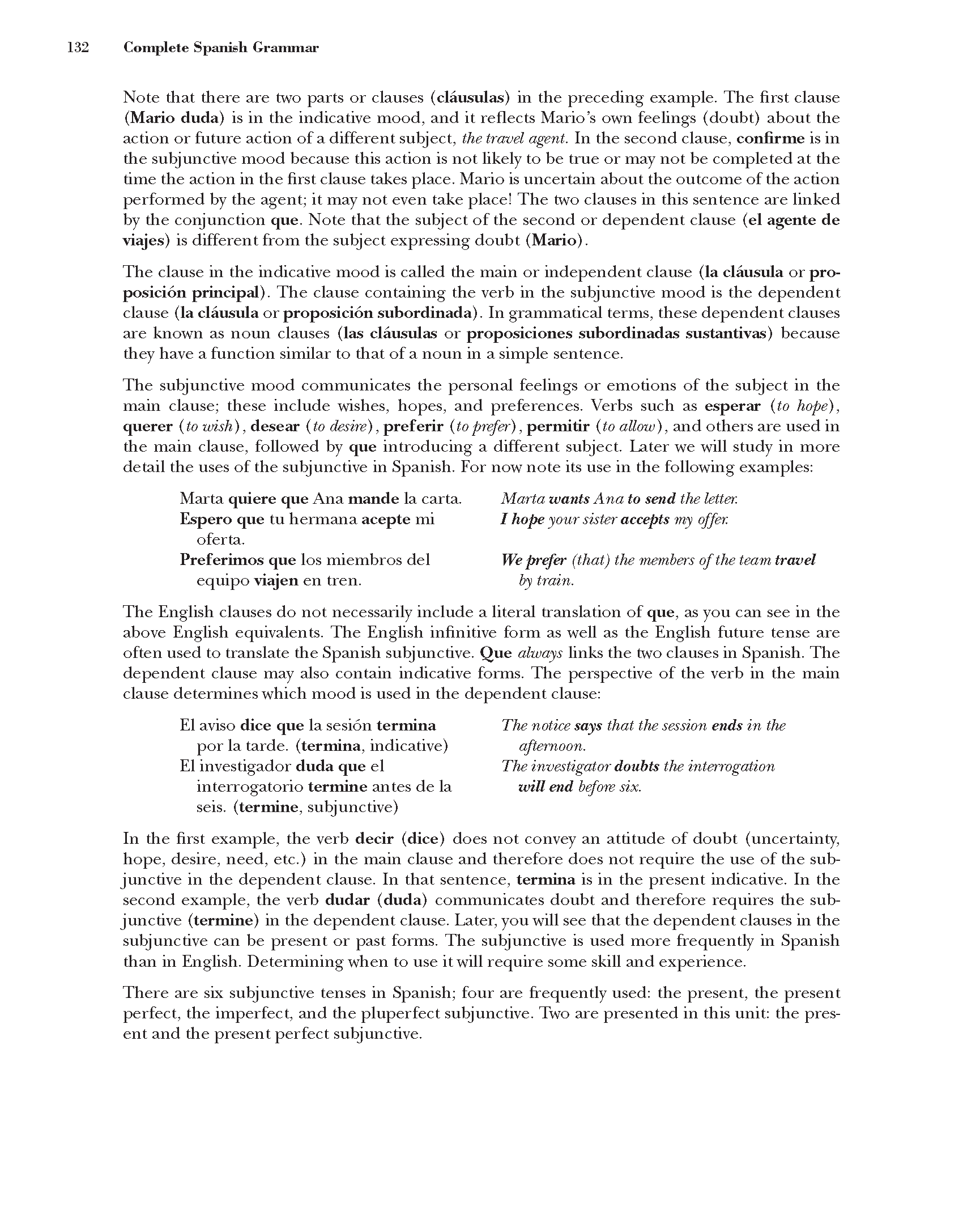CSG143

Complete Spanish Grammar
Notę that there are two parts or clauses (clausulas) in the preceding example. The first clause (Mario duda) is in the indicative mood, and it reflects Mario s own feelings (doubt) about the action or futurę action of a different subject, the trcwel agent. In the second clause, confirme is in the subjunctive mood because this action is not likely to be true or may not be completed at the time the action in the first clause takes place. Mario is uncertain about the outcome of the action performed by the agent; it may not even take place! The two clauses in this sentence are linked by the conjunction que. Notę that the subject of the second or dependent clause (el agente de viajes) is different from the subject expressing doubt (Mario).
The clause in the indicative mood is called the main or independent clause (la clausula or pro-posición principal). The clause containing the verb in the subjunctive mood is the dependent clause (la clausula or proposición subordinada). In grammatical terms, these dependent clauses are known as noun clauses (las clausulas or proposiciones subordinadas sustantivas) because they have a function similar to that of a noun in a simple sentence.
The subjunctive mood communicates the personal feelings or emotions of the subject in the main clause; these include wishes, hopes, and preferences. Yerbs such as esperar (to hope), querer (to wish), desear (to desire), preferir (toprefer), permitir (to allow), and others are used in the main clause, followed by que introducing a different subject. Later we will study in morę detail the uses of the subjunctive in Spanish. For now notę its use in the following examples:
Marta quiere que Ana mande la car ta. Marta wants Ana to send the letter.
Espero que tu hermana acepte mi I hope your sister accepts my offer.
oferta.
Preferimos que los miembros del We prefer (that) the members of the team travel
equipo viajen en tren. by train.
The English clauses do not necessarily include a literał translation of que, as you can see in the above English equivalents. The English infinitive form as well as the English futurę tense are often used to translate the Spanish subjunctive. Que always links the two clauses in Spanish. The dependent clause may also contain indicative forms. The perspective of the verb in the main clause determines which mood is used in the dependent clause:
El aviso dice que la sesión termina por la tarde. (termina, indicative) El investigador duda que el
interrogatorio termine antes de la seis. (termine, subjunctive)
The notice says that the session ends in the afternoon.
The investigator douhts the interrogation will end before six.
In the first example, the verb decir (dice) does not convey an attitude of doubt (uncertainty, hope, desire, need, etc.) in the main clause and therefore does not require the use of the sub-junctive in the dependent clause. In that sentence, termina is in the present indicative. In the second example, the verb dudar (duda) communicates doubt and therefore requires the sub-junctive (termine) in the dependent clause. Later, you will see that the dependent clauses in the subjunctive can be present or past forms. The subjunctive is used morę frequently in Spanish than in English. Determining when to use itwill require some skill and experience.
There are six subjunctive tenses in Spanish; four are ffequently used: the present, the present perfect, the imperfect, and the pluperfect subjunctive. Two are presented in this unit: the present and the present perfect subjunctive.
Wyszukiwarka
Podobne podstrony:
2.2.3 Primary and secondary services There are two classes of allocation shown in the following Tabl
CSG107 96 Complete Spanish Grammar Remember that -er and -ir verbs have the same ending. The bus is
CSG107 96 Complete Spanish Grammar Remember that -er and -ir verbs have the same ending. The bus is
CSG107 96 Complete Spanish Grammar Remember that -er and -ir verbs have the same ending. The bus is
CSG127 116 Complete Spanish Grammar Remember that: • all auxiliary (haber) futurę
CSG307 296 Complete Spanish Grammar ejercicio Lo opuesto. Escńbe las frases en forma negativa. In so
DSC09922 There are two forms of hydrocephalus: Noncommunicationa hydrocephalus-the obstruction to th
CSG141 130 Complete Spanish GrammarImpersonal Constructions Used to Suhstitute for Passive Construct
CSG273 262 Complete Spanish Grammar En esa epoca, no habfa telefonos At that time,
więcej podobnych podstron